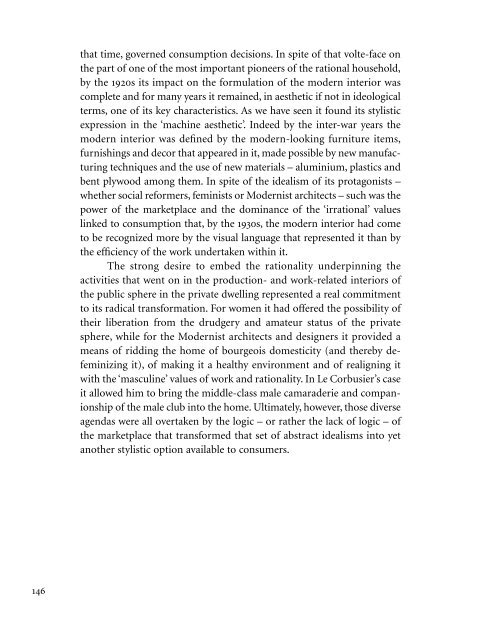You also want an ePaper? Increase the reach of your titles
YUMPU automatically turns print PDFs into web optimized ePapers that Google loves.
146<br />
that time, governed consumption decisions. In spite of that volte-face on<br />
the part of one of the most important pioneers of the rational household,<br />
by the 1920s its impact on the formulation of the modern interior was<br />
complete and for many years it remained, in aesthetic if not in ideological<br />
terms, one of its key characteristics. As we have seen it found its stylistic<br />
expression in the ‘machine aesthetic’. Indeed by the inter-war years the<br />
modern interior was defined by the modern-looking furniture items,<br />
furnishings and decor that appeared in it, made possible by new manufacturing<br />
techniques and the use of new materials – aluminium, plastics and<br />
bent plywood among them. In spite of the idealism of its protagonists –<br />
whether social reformers, feminists or <strong>Modern</strong>ist architects – such was the<br />
power of the marketplace and the dominance of the ‘irrational’ values<br />
linked to consumption that, by the 1930s, the modern interior had come<br />
to be recognized more by the visual language that represented it than by<br />
the efficiency of the work undertaken within it.<br />
<strong>The</strong> strong desire to embed the rationality underpinning the<br />
activities that went on in the production- and work-related interiors of<br />
the public sphere in the private dwelling represented a real commitment<br />
to its radical transformation. For women it had offered the possibility of<br />
their liberation from the drudgery and amateur status of the private<br />
sphere, while for the <strong>Modern</strong>ist architects and designers it provided a<br />
means of ridding the home of bourgeois domesticity (and thereby defeminizing<br />
it), of making it a healthy environment and of realigning it<br />
with the ‘masculine’ values of work and rationality. In Le Corbusier’s case<br />
it allowed him to bring the middle-class male camaraderie and companionship<br />
of the male club into the home. Ultimately, however, those diverse<br />
agendas were all overtaken by the logic – or rather the lack of logic – of<br />
the marketplace that transformed that set of abstract idealisms into yet<br />
another stylistic option available to consumers.



